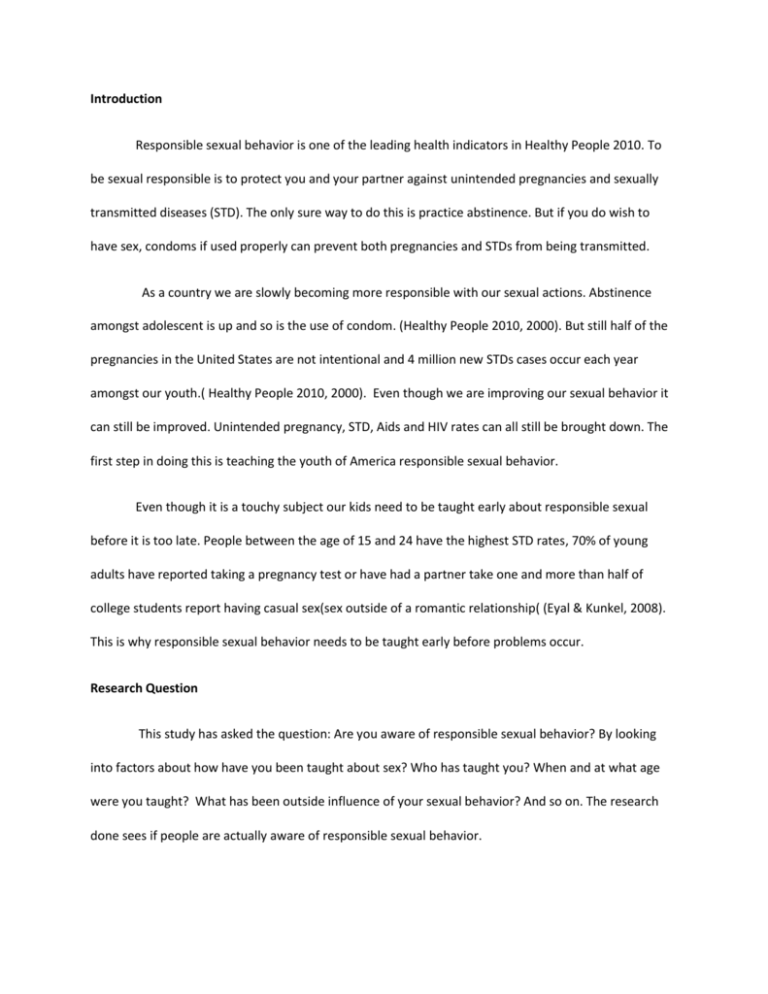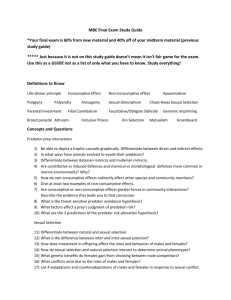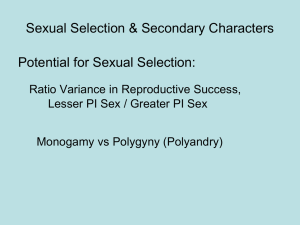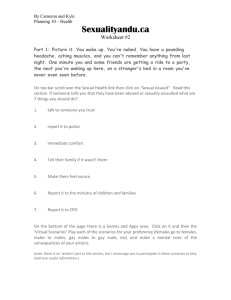
Introduction
Responsible sexual behavior is one of the leading health indicators in Healthy People 2010. To
be sexual responsible is to protect you and your partner against unintended pregnancies and sexually
transmitted diseases (STD). The only sure way to do this is practice abstinence. But if you do wish to
have sex, condoms if used properly can prevent both pregnancies and STDs from being transmitted.
As a country we are slowly becoming more responsible with our sexual actions. Abstinence
amongst adolescent is up and so is the use of condom. (Healthy People 2010, 2000). But still half of the
pregnancies in the United States are not intentional and 4 million new STDs cases occur each year
amongst our youth.( Healthy People 2010, 2000). Even though we are improving our sexual behavior it
can still be improved. Unintended pregnancy, STD, Aids and HIV rates can all still be brought down. The
first step in doing this is teaching the youth of America responsible sexual behavior.
Even though it is a touchy subject our kids need to be taught early about responsible sexual
before it is too late. People between the age of 15 and 24 have the highest STD rates, 70% of young
adults have reported taking a pregnancy test or have had a partner take one and more than half of
college students report having casual sex(sex outside of a romantic relationship( (Eyal & Kunkel, 2008).
This is why responsible sexual behavior needs to be taught early before problems occur.
Research Question
This study has asked the question: Are you aware of responsible sexual behavior? By looking
into factors about how have you been taught about sex? Who has taught you? When and at what age
were you taught? What has been outside influence of your sexual behavior? And so on. The research
done sees if people are actually aware of responsible sexual behavior.
Significance of the Problem
The significance of this study is to see if by the time people are sexual active are they aware of
ways to bee sexually responsible or are they still in the dark about what is responsible. By looking into
this subject we may be better able to explain why half of pregnancies are unexpected, why youths have
the highest STD rate and other problems our country has when it comes to sex. By answering this
question we may be able to find better ways to make people be more aware of responsible sexual
behavior and reduce these problems.
Review of Literature
Overview of Sexual Behavior
While reading this article, I realized it was an observational, cross-sectional design study about
middle school students. The middle school students added up to one thousand, two hundred seventy
nine students from ten middle schools in a large southeastern United States public school district. The
young adolescents were followed by answering questions on a computer assisted self interview. The
students were to answer the questions on the self interview about their experiences of vaginal, oral,
and/or anal sexual intercourse over the past three months.
The findings of the self-assessments stated that about two-thirds of the students were currently
sexually active. I found that to be ridiculous being that the students are at such a young age. The
demographics of the students studied, were all very similar but not totally. The only differences I noticed
were gender, race, and ethnicity. I think it is important that the students observed are generally from
the same demographic. This means that since the students are from the same area which could possibly
have an effect on the results because if certain students in an area are doing one thing that can lead to
other students following along to do the same thing. The differences of the observed population could
also have an effect on the results. There are usually different opinions that come along with people from
different backgrounds, races, and ethnicities.
This study proved that students are becoming sexually active at a younger age.
Sex and the Media
Every day we are all exposed to sex in some way. Whether through television, music, books or
even a billboard advertisement, sex is everywhere. The media exposes all of to this. One of the most
high end fashion brands in the world, Dolce and Gabanna, Spring 2006 ad campaign featured men with
clothes off staring at each other (Reichert, 2007). In a study done in 2003 it was found that 71% of prime
time TV contained sexual content in some way (Reichert, 2007) Avoiding sex in the media is impossible
and this affects our outlook on sex especially amongst teens who get most of their sex education during
these years. Sex is not put into our everyday media to inform us about sex. But rather it is put into the
media to sell a product. This product could be a TV show, a beer, a CD or anything. The media is not
concerned with the message they send by putting sex into their product but whether or not they profit
off the product.
What an adolescent is exposed to in the media can and most likely will affect their outlook on
sex and what is appropriate and inappropriate. Exposing our youth to sex is not necessarily a bad thing.
But the youth that are being expose to this needs to understand that what the media is depicting is not
real life and must understand there are consequences for their sexual action. When adolescents here
the word consequences though they usually think of it in a negative term. Sex can have positive and
negative consequences. This is why proper sexual behavior must be understood while watching shows
that depict sex. The media for the most part sends the message the sex is something we all should do
but never depicts the consequence of having sex.
The media is the fourth largest source that youths use to get information about sex behind
friends, teachers and mothers (Bleakly, 2009). The two largest sources of media that is youths use to
gain information about sex is television and movies (Bleakly, 2009). Television in considered to be the
key socializing agent amongst young people (Eyal & Kunkel, 2008). This is because all youths tend to
watch the same shows which bring them together socially. The more popular shows being the ones with
more sexual content. The sexual acts that are performed on these shows never actually show the
negative and positive consequences mentioned earlier. Rather they depict a gray area that leaves you to
guess the outcome of what just happened (Eyal & Kunkel, 2008).
This gives youths a mix message about sex and the consequences that may occur. By not seeing
negative or any consequence at all for a sexual act adolescents may think that what they are doing is
acceptable. And the act may be acceptable. A man and woman who are happily married and make love
is perfectly fine and sends a positive message. But showing a one night stand and then making light of it
afterwards is not a message you want to send to youths. They may see this as an acceptable act and try
to do the same thing.
According to a study done called “How Sources Of Sexual Information Relate to Adolescent’s
Beliefs About Sex,” most adolescents beliefs that sex had positive outcomes. They believed that sex
would increase their overall pleasure, feel good about themselves and increase their self efficacy. The
study helps to show that the media can have a negative affect on our youth and how they look at sex.
Youth should understand that yes all of that can come out of sex but the media does not show them
responsible sexual behavior.
In an experiment done by Karen Eyal and Dale Kunkel helps support that adolescents who are
exposed to television with sexual acts can have a positive effect of an adolescents view on sex. When
showed television with sexual acts that had a negative consequence the youths had a more negative
outlook or premarital sex then before viewing the show (Eyal & Kunkel, 2008). This helps the argument
that you can show sex on TV and not have it give adolescents the wrong idea about sex. Even though
that showing a negative consequence for having sex is almost a scare tactic it does reduce youth views
about premarital sex.
The two good examples of positive and negative consequence of the media using sex are the
movies Juno and Knocked Up. Juno depicts a high school girl who gets pregnant by her boyfriend and
shows how she deals with all the consequences of what just happened. If watched by an adolescent
they can see all of the negative consequences that can come along irresponsible sexual behavior. How it
does not only affect you but your partner, your family and everybody around you. Even though the
movie is meant for entertainment purposes it does show youths what can happen and sends the right
message.
The movie Knocked Up is about two people that get blacked out drunk in a club one night, have
a one night stand and she winds up getting pregnant. The movie is comedic in every aspect of the events
that follow and makes light of a very serious situation. And like with most movies in the end everything
works out. This is not sending the right message to adolescents. The message this movie sends is that if
you do have a one night stand and a pregnancy does occur that it will all work out in the end. If an
adolescent does watch this they need to understand that it is not real life but a movie.
The main problem with sex in the media is not that they show sex, but rather the way they show
it. The media uses sex to do one thing and that is to sell. Sell their TV shows, CDs, beers; whatever it may
be they use sex to sell. And what the adolescents do not see is that there are responsible sexual
behaviors that need to be practiced. What the youths see is the act of sex and all the happiness that
comes as a result. What youths need to understand though is that the media uses sex as selling tool and
not as something they should emulate.
Sex Education in the Classroom
Responsible sexual behavior is a topic that is affected by so many outside influences. A major
influence on this behavior comes from what a person learns and experiences in their schooling system.
There are three different forms of sex education going around in the schools today and all three of them
have positives and negatives. The first and most common method is abstinence only. This method
focuses on telling teenagers in school to never have sex until they are married or older and mature. In
an article titled “An Evaluation of an Abstinence-Only Sex Education Curriculum: An 18-Month Followup” students in 15 districts ranging from elementary school, middle school, and high school were placed
in a “sex can wait” curriculum. Along with this curriculum was the schools’ normal sex education
program, which was being taught to the students not placed in the “sex can wait” program.
At the end of the year the students were tested in many different areas related to sex and how
they felt about themselves. The “Sex Can Wait” group, in upper elementary levels, had a higher level of
knowledge, indicated more hopefulness for the future, and greater self-efficacy than did the comparison
group (Denny and Young, 2006). Also in the “Sex Can Wait” group it was found that they had a higher
level of knowledge and was less likely to report participation in sexual intercourse in the last month
(Denny and Young, 2006). The cases were very similar in results when it came to middle school and high
school regarding all of these categories. Even though these results put abstinence in a good light, there
are still negatives to it. For example, if a child were put in the situation where there was going to be
sexual intercourse of some sort, the child would not know what to do and how to be safe about it. In
addition, when taught abstinence only there is no knowledge given on how to avoid STD’S and how to
actually practice safe sex.
The next form of sexual education involves teaching students how to practice safe sex, gives
them knowledge of diseases, and teaches them to explore their bodies. This form of sex education is a
new one and it is starting to become more popular. It's not about advocating sex, the experts say,
rather, it's the belief that radical openness will demystify sex and help give teens the confidence to
make smarter choices (George, 2009). That is the exact goal of this method of teaching, making sex such
a common knowledge that children don’t think of it as something that is more amazing than the norm.
“What we have found is, if you talk about how to prevent STI’s, youth tune you out, if you talk about
how things work and what are the different options, they pay attention. There are safer-sex messages
implicit in what we say, but it's within a package that's more interesting to them" (George, 2009).
Basically, if you tell a child no, they want what you’ve said no to, but if you tell a child yes and here are
the options, they will listen in and accept what you have to say.
The negative to this method of teaching is that children, with all of this knowledge, will go out
and practice what they have learned. A child might figure that since they have learned all the
precautions they can be sure to not obtain any of the side effects. This would be the opposite effect of
what this form of teaching would want. Another negative effect is how the parents will react. The
situation of a parent’s child coming home talking about vibrators, sex, and STD’s is a big fear that a
parent could not think highly of (George, 2009).
The third and final form of sex education would be a combination of both, abstinence and the
teachings of how to be knowledgeable about safe sex. This form of sex education is used in many
schools and too has its positives and negatives. The SIECUS, Sexuality Information and Education
Council of the United States, is the organization that promotes this kind of thought. SIECUS advocates
for the youth, and other organizations who support comprehensive sexuality education also support
teaching young people about abstinence. They do not, however, support teaching young people only
about abstinence or using fear and negative messages to motivate behavior (Anonymous, 2001). This is
a very popular form because it teaches children to not have sex until they are older but, if the situation
does arise they will have the proper knowledge to perform what they are going to do.
The negative side to this form of sex education is that children could become confused when
being taught to not have sex, but at the same time how to have it. This could affect a child growing up
because being confused about what to do will cause them to either be completely scared to have sex or
go out and have it frequently. The knowledge aspect of this form of teaching should be the greatest in
which children are learning how to have sex, to prevent disease, and to wait until you are older.
Sex and Parental Influences
After reading over the research I found, “Sex study, big gap between parental desires and classroom
realities”, I learned that for the most part parents do what want sexual education in classrooms. This
was a very interesting research study because it compared the parents, the teachers and the principals.
There was also a very big difference between what parents want to be happening and what is happening
in the classroom. The difference between what the students are actually learning and what the parents
want them to learn is too big of a gap.
I was shocked to read that for the most part, parents do want their children to learn about the
pressure, the consequences, the emotional issues and the different methods of contraceptives. The
parents desire to have sexual education in classes has dramatically increased. In 1981, 84% of parents
favored teaching about sexually transmitted diseases and today 98% parents favor that topic now. 54 %
of parents wanted the topic of abortion covered compared to 79% of parents today and 45% of parents
supported some discussion of homosexuality compared to 76% today.
It is very interesting to be able to compare how teachers felt more than thirty years ago and also
how little the schools are changing their curriculum. Sex Education in school is a very touchy subject and
whether some parents would rather just turn the other way, it needs to be taught. Students are
becoming sexually active earlier each year and in my opinion I do believe it is because of the lack of
education in schools. It will be a lot easier if the schools have both the teacher and the parent’s
cooperation to be able to talk about sex during the school period. I do believe that there will be less
teenage pregnancies and diseases that could be easily prevented.
Methodology
Subjects
The subjects involved in our study are 100 Rowan University students. 50 of the subjects male
and 50 of them female. We are randomly selecting students throughout the Rowan campus to get the
best feel for the student population. The criteria that we required are that they are a full time,
undergraduate, Rowan University student. The subjects we chose were of various ethnic backgrounds,
between the ages of 18 and 22, and lived in the New Jersey, Pennsylvania area.
Data Collected
We collected data by going up to random students and asking them to participate in a
completely confidential survey. If they agreed they completed a survey and put in an envelope
themselves so we could not distinguish what paper was theirs.
When we designed the survey we put it into two categories, knowledge and behavior. The
knowledge section of the survey helped us to get a feel of their understanding of responsible sexual
behavior. Next we ask them about their sexual behavior practices to see if this went along with what
they learned and if they actually did practice proper sexual behavior.
After running a pilot test we saw a few flaws in the survey. We reworded some of the questions
so they could be better understood. Also the answer options too few question were expanded beyond
yes or no. Otherwise the original design of the survey stayed the same.
Timeline
We conducted the pilot test during one of our classes with a few students in the class. We felt
this was the best group to do it with since they were aware of what was going on and that it was on a
pilot run. Based on what they answered we were able to make some adjustments. We are going to
conduct the actual survey during the week of March 21st.
Results
The group of Rowan Unervisty Students that we surveyed were between the ages of eighteen
and twenty three. The grade range was from freshman to super seniors. We purposly surveyed fifty
male and fifty females so our results did nto favor one gender over another. The first section of question
we asked was about students knoweldge of proper sexual behavior.
Females No
Females Yes
Males No
Males Yes
Fig. 1
0
5
10
15
20
25
30
35
40
45
Our first question asked if students were taught how to properly use a condom (Fig. 1). We
found that more males were taught how to properly use a condom then females. 82% of males said they
were taught proper condom use. While females were ten percent less with only %72 percent saying they
were taught proper condom use.
Females No
Females Yes
Males No
Males Yes
Fig. 2
0
5
10
15
20
25
30
35
40
45
We then asked students if they believed you can catch an STI even if you use a condom (Fig. 2).
The correct answer to this question is yes you can catch an STI even if you use a condom. We found that
almost an equal amount of males and females knew this. There was only one more female then male
that knew this was true (40 Males and 41 Females).
Females No
Females Yes
Males No
Males Yes
Fig. 3
0
5
10
15
20
25
30
35
40
45
50
Since birth control is very popular today we asked students if they were aware that you can still
catch an STI if you or your partner is on the pill (Fig. 3). A very high percentage of students knew that
this was true. 96% of the males we surveyed were aware and 94% of the females were aware of this
fact.
Females No
Females Yes
Males No
Males Yes
Fig. 4
0
5
10
15
20
25
30
35
Females No
Females Yes
Males No
Males Yes
Fig. 5
0
5
10
15
20
25
30
35
40
45
50
The next two questions had to do with how you were taught proper sexual behavior. The first
questioned asked if your parents taught you about sexual behavior (Fig. 4). The number of students that
answered yes to this was not that high. Thirty-one males (62%) and twenty-seven females (54%) said
that their parents talked to them about sexual behavior. We followed that up with a question asking
students if they were taught about proper sexual behavior in school before Rowan (Fig. 5). There was a
pretty significant difference in these numbers. 94% of the males surveyed said that there were taught
proper sexual behavior on school while only 72% of females said yes.
The next set of questions had to do with your sexual behavior. The first question we asked
students was if they are sexually active. We had the same numbers for both genders with this question
with forty-three of the fifty students we surveyed being sexually active.
Females No
Females Yes
Males No
Males Yes
Fig. 6
0
5
10
15
20
25
30
35
40
45
Since alcohol is commonly used amongst the college community the next question we asked
was if you are more likely to participate in sexual acts if you are intoxicated (Fig. 6). These figures
showed that males are much more likely to participate in a sexual act if intoxicated then females. 92% of
guys aid yes they are more likely to do so. While comparatively, just 58% of females said they would
participate in a sexual act.
The rest of the questions on our survey were answered only if you answered yes to being
sexually active. This is due to the fact that you need to be sexually active for these questions to pertain
to you. The next two questions did not take into account if a person or their partner is one birth control.
We asked students if they use or make their partner use a condom (Fig. 7). The majority of males (42%)
answered sometimes to this question. The majority of females said yes at 51%. Just 35% of males said
yes to this question and 28% of females said sometimes.
Females No
Females Sometimes
Females Yes
Males No
Males Sometimes
Fig. 7
Males Yes
0
5
10
15
20
25
That question was followed up with do you use condoms every time you have sex (Fig. 8)? This
question was different from the one before it because it is meant to find out who uses condoms every
time they have sex instead of some of the time. For both males and females the answer more students
answered no. 77% percent of males said they do not use a condom every time they have sex. Just above
half of females at 58% said they always make their partner use a condom.
Females No
Females Yes
Males No
Males Yes
Fig. 8
0
5
10
15
20
25
30
35
Before becoming sexually active with a person it is beneficial to know their sexually history. So
we asked students if they were aware of their partner’s sexual history before becoming sexually active
with them (Fig. 9). This question like one asked in Figure 7 had more females answering yes and more
males answering sometimes. 51% of males said they know this information sometimes and 56% of
females said they know their partners sexual history. Only 16% for both males and females said they are
never aware o their partners sexual history.
Females No
Females Sometimes
Females Yes
Males No
Males Sometimes
Males Yes
Fig. 9
0
5
10
15
20
25
The last question we asked the students who took our survey is straight from our research
question. Do you believe you were aware of proper sexual behavior before becoming sexually active (Fig
10)? Most males believed they were aware of proper sexual behavior with 95% saying yes. Females on
the other hand did not have as high of a percentage saying yes with 70%
Females No
Females Yes
Males No
Males Yes
Fig. 10
0
Discussion
5
10
15
20
25
30
35
40
45








